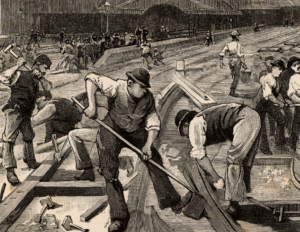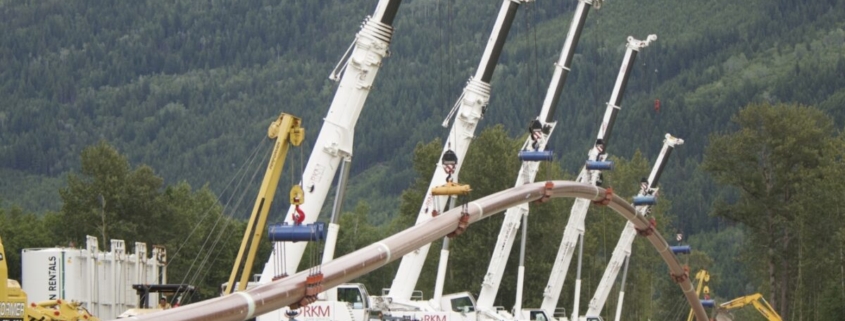Learnings from building Canada’s railway for today’s megaprojects
 Slashing Canada’s greenhouse gas emissions to 40 per cent to 45 per cent below 2005 levels by 2030 and reaching net zero by 2050 is no small endeavour. Think long electricity transmission lines, carbon pipelines, hydrogen facilities and new critical mineral mines. The green shift will require hundreds of billions of dollars in new investments across the country.
Slashing Canada’s greenhouse gas emissions to 40 per cent to 45 per cent below 2005 levels by 2030 and reaching net zero by 2050 is no small endeavour. Think long electricity transmission lines, carbon pipelines, hydrogen facilities and new critical mineral mines. The green shift will require hundreds of billions of dollars in new investments across the country.
It’s kind of like Canada’s first megaproject, the Canadian Pacific Railway (CPR). It, too, was a colossal undertaking to build infrastructure across this vast, sparsely populated land from coast to coast. It, too, faced huge challenges.
But where they differ is that, despite all its challenges and the technological limitations of the time, the CPR was completed in just five years – twice as fast as the federal government had anticipated. The last spike was pounded in 1885.
Fast-forward 140 years and such megaprojects are slow to build in Canada. It can take more than 10 years from start to finish – if it begins.
Oil and gas companies have experienced this with their repeatedly stalled and cancelled projects. The mining sector saw this in the denied Baffinland Iron Mines Corp. expansion last week In Nunavut. Now the same problem ironically plagues the big projects vital to the energy transition.
With the UN climate conference having just come to a close in Egypt, Canada is once again promising to reduce our greenhouse gas emissions. But to reach net zero by 2050, developments will need to move faster.
And there is a lot we can learn from how Canada built the railway.
Back then, there was no environmental or regulatory review process. As a result, the railway altered the migration of animals, blasted away mountains and changed waterways. Its construction killed thousands of workers and forever changed the lives of Canada’s Indigenous people. This clearly illustrates why regulatory reviews and rules are needed.
However, the pendulum has now swung too far in the other direction. If Canada is to achieve its ambitious emission-reduction goals, the review process must become more streamlined, fast and predictable. If not, companies will not invest in Canada, and the country’s climate goals will not be met.
Past failures illustrate the risk. The Enbridge Northern Gateway, Teck Frontier and Pacific Northwest LNG projects each undertook a four- to eight-year regulatory process, only to be cancelled. As a consequence, each wrote off between $500-million and $1-billion.
Think about that: The review process alone can take longer than it took to build Canada’s entire national railway, and companies could risk losing hundreds of millions of dollars in the process.
The risk of failure is not exclusive to oil and gas. Clean energy projects also carry risk. The review process for mines is long, and the outcomes are uncertain. For example, the New Prosperity Gold-Copper Mine project was denied after a multiyear review. Transmission lines and other infrastructure to support electrification can also be controversial. And while no interprovincial, large-scale hydrogen or carbon pipeline projects have been developed yet, they are likely to face some opposition.
Adding to the uncertainty, the controversial Impact Assessment Act (formally known as Bill C-69) came into force in 2019. The act widens the scope and requirements for environmental assessments. One of its positive features is that it enshrines time limits for reviews. However, even if these limits are enforced, it can still take four to five years to complete.
On top of all that, a serious risk for companies wanting to build large projects in Canada is that the final decision is political. At the end, the green light is given by either the federal environment and climate change minister or the prime minister and his cabinet. Projects have been cancelled on political calculus before. Take the Northern Gateway project, for example.
Another barrier is that cities, counties, provinces and federal authorities each require their own approvals and permits. This creates costly delays and uncertainty for project developers.
The railway did not have these challenges, but it had its own difficulties. A southern route over the mountains in Alberta and British Columbia had to be found. A shortage of workers was another issue. The remote, cold and sparsely populated country meant the railroad needed to provide all the necessary infrastructure to support the workers, including food and housing. Winter weather usually shut down construction. And, as a result of these and other issues, the project’s costs ballooned.
While these issues were specific to the railway, their relative magnitude at the time was similar to the issues faced by proponents of megaprojects today. And there is a lot we can learn from how those railway issues were resolved: not just through the unrelenting drive of the CPR’s leaders, but by those in power who recognized the national importance of Canada’s first railway.
Our country’s leaders back in the day summoned the political will to push the project through because they knew they were working toward a vision bigger than themselves.
The railway’s completion in five years showed that a national imperative combined with entrepreneurial drive can overcome huge obstacles.
Recently, there have been glimmers of hope that things can improve. The federal government is starting to acknowledge the problem.
Speaking at the Brookings Institution in Washington last month, Deputy Prime Minister Chrystia Freeland said Canada must fast-track energy and mining projects to speed up the green transition and help our allies. Natural Resources Minister Jonathan Wilkinson recognized the issue in a recent speech in Calgary, saying he is organizing regional roundtables to find solutions for speeding up projects. The government’s fall economic statement also provided additional funding for regulatory agencies to improve the efficiency of assessments.
If Canada has any hope of achieving its ambitious emission-reduction goals, projects must be done differently and faster. The story of our first railway proves that big things are possible.
This article was originally published in the Globe and Mail.



